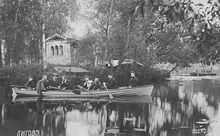Ligovsky Pond
| Ligovsky pond | |
|---|---|
 German map of 20th century | |
| Location | Ligovo, suburb of Saint Petersburg |
| Coordinates | 59°49′24″N 30°11′03″E / 59.82333°N 30.18417°ECoordinates: 59°49′24″N 30°11′03″E / 59.82333°N 30.18417°E |
| Lake type | Artificial, former |
| Primary inflows | Dudergofka river |
| Primary outflows | Dudergofka river |
| Basin countries | Russia |
| Max. length | 1.7 km (1.1 mi) |
| Islands | Love island with grotto |
| Settlements | Ligovo |
Ligovsky pond (Russian: Лиговский пруд) is artificial lake existing in Ligovo, suburb of Saint Petersburg (Russia) in 1716-1941.

In 1703 Peter I had been based the city of Saint Petersburg and this area became capital suburb. In 1710s emperor has taken part in destiny of settlement - it has enjoined to block the Dudergofka river in 1715. On a dam the watermill which specialised on flour-grinding and felting works has been constructed.[1]
Simultaneously with barrage of Dudergofka river has been dug the Ligovsky channel. It has taken away an essential part of water from Dudergofka and the artificial lake became a source of water for Ligovo. At that time surrounding district represented imperial grange for maintenance of a palace with the foodstuffs; there was a dairy farm, kitchen gardens.[1]
When in 1765 owner of district became Grigory Orlov, for it on the bank of lake buildings have been built. On the western coast of a pond were the house with landing stage and economic constructions. On east coast the manour house where Orlov accepted Russian empress Catherine II has been constructed.[1]
After 1783, when Grigory Orlov is dead, earths of Ligovo have been inherited by its pupil Natalia Alekseeva, she was married for aide-de-camp of Orlov Friedrich Wilhelm von Buxhoeveden. In 1840s the manor of Buxhoeveden has passed to count G. G. Kushelev-Bezbordko (younger), it has continued useful agricultural activity of count Orlov, and Ligovo became an exemplary agricultural manor. Have spent a network of avenues and paths, have created specific hills, have dug out ponds. The house has a connected covered transition to kitchen, to the north from it have organised separate zones — an orchard with greenhouses, stables, the bird's and cattle courtyard. Lake coast too have improved - by the architect A. Stackenschneider have been constructed terrace, going down from the house to lake, a grotto on love island.[1]

After Kushelev-Bezbordko's death the manor gradually fell into decay. In 1857 in Ligovo has come Baltic railway, by the end 1870s vicinities Ligovsky pond became country area; on lake summer residents went for a drive on boats. To October Revolution in 1917 the lake, a dam and a mill were supported as it should be. After that the mill has stopped, contemporaries recollected that water falls fell from a dam.[1]
The pond mirror was supported by a dam of a mill till 1941. On 5 December, 1941 German armies destroyed the dam on the approach to Leningrad. After the Second World War hydraulic work was not restored. On a lake place the big ravine which has grown with a bush settles down. The territory of the former lake is not built up - it is a memorial zone: in fights on this place was lost more than 700 persons. Near to the former lake the memorial Orthodox church is under construction.
References
- ↑ 1.0 1.1 1.2 1.3 1.4 Russian: Аминов Д., D. Aminov (1990). "Лигово - Урицк" [Ligovo-Uritsk]. Dialog Russian: Диалог (in Russian) (Leningrad obkom CPSU Russian: Ленинградский обком КПСС). Retrieved 2009-07-02.
| |||||
| |||||||
